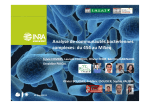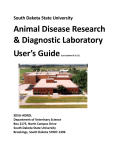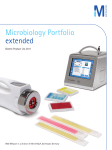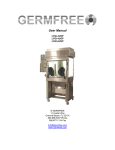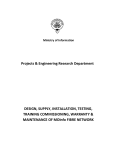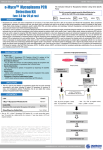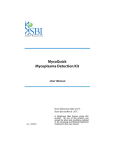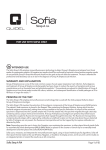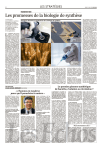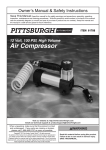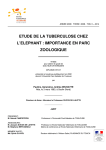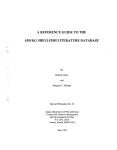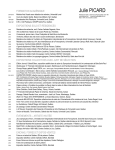Download E-myco plus user manual
Transcript
For research purpose only. Not for use in diagnostic procedures for clinical purposes. For IN VITRO USE ONLY. ISO 9001/14001 Certified Company e-MycoTM plus Mycoplasma PCR Detection Kit Cat. No. 25234 96 Tests ( for 20 µl rxn ] DESCRIPTION • Mycoplasma is a genus of bacteria which lack a cell wall. Without a cell wall, they are unaffected by many common antibiotics such as penicillin or other beta-lactam antibiotics that target cell wall synthesis. They can be parasitic or saprotrophic. Several species are pathogenic in humans, including M. pneumoniae and M. genitalium. Mycoplasma species are often found in research laboratories as contaminants in cell culture. Mycoplasmal cell culture contamination occurs due to contamination from individuals or contaminated cell culture medium ingredients. • Mycoplasma cells are physically small (< 1 µm) and are difficult to detect with a conventional microscope. Mycoplasmas may induce cellular changes, including chromosome aberrations, changes in metabolism and cell growth. Severe Mycoplasma infections may destroy a cell line. Several methods for the detection of Mycoplasmas have been published. The testing required by the regulatory authorities is seeding in culture (agar and liquid media). This test is complicated, time consuming (about 3 ~ 5 weeks), and some Mycoplasma species are difficult to detect with this method. In recent years, the disadvantages of these methods have been acknowledged (such as sensitivity, specificity and long and complex procedures), and use of PCR for the detection of contaminations in cell cultures has become increasingly widespread. • e-Myco™ plus Mycoplasma PCR Detection Kit greatly simplify testing and detection of Mycoplasma contamination in cell cultures. With PCR testing, reliable results are obtained within a few hours, since the presence of contaminant Mycoplasmas can be easily and sensitively detected by simply verifying the bands of amplified DNA fragments after gel electrophoresis. The e-Myco™ plus Mycoplasma PCR Detection has been shown to be a highly sensitive, specific and rapid method for the detection of Mycoplasmas contamination in cell cultures. • Though the gene sequences for 16S rRNA are very similar in most Mycoplasma species, there are some differences in the sequences of 16S rRNA gene between certain Mycoplasma species and the other species. Specific primers set of e-Myco™ plus Mycoplasma PCR Detection Kit was designed from DNA sequences that are coding for highly conserved 16S rRNA with considering above point. Thus e-Myco™ plus Mycoplasma PCR Detection Kit can be used in the detection of more broad range of Mycoplasma species, compared with any other commercially available PCR-based Mycoplasma detection kit, without interfering with animal or bacterial DNA. • An internal control of this product was constructed to identify false negative results in each reaction. The internal control was designed in such a way that the primers set was used to amplify the internal control and target DNA, which were differentiated by size. Furthermore, the sample control was provided with this kit for using in verifying the effectiveness of template DNA. So, You may easily check your sample preparation. In addition, the use of 8-methoxypsoralen (8-MOP) was adopted in this kit. 8-MOP is known to intercalate into double-stranded nucleic acids and form a covalent inter-strand crosslink after photo-activation by incident light at wavelength 320-400 nm, so it is helpful to prevent cross-contamination by PCR products from earlier experiments. • Each tube of the e-Myco™ plus Mycoplasma PCR Detection Kit contains all the components for PCR except for template: DNA Polymerase, dNTPs, PCR Buffer, primers set, 8-MOP, and internal control. So, you can just add your templates and perform the PCR reaction. CHARACTERISTICS • Premix Type - This e-Myco™ plus Mycoplasma PCR Detection Kit contains all the components for the PCR reaction. You just add a template and DW. • Wide Range of Detectable Mycoplasmas - You can detect not only five common cell culture-infecting species of mycoplasma but also other various species of Mycoplasma over 8 genus 209 species (See Technical Guide). • Internal Control - Internal control embedded in the product prevents misjudgment that possibly arises from an erroneous PCR test. • Sample Control - You can verify easily the effectiveness of template gDNA by checking the amplification from sample control. • Species Determination - You can determine the species of Mycoplasma by sequencing the amplified PCR products. • Elimination of Cross-Contamination - 8-MOP prevents cross-contamination by PCR products. APPLICATIONS • The kit is used for the detection of Mycoplasma species that are most commonly encountered in cell culture, including M. arginini, M. fermentans, M. hyorhinis, M. orale, and Acholeplasma laidlawii. Furthermore, a most kinds of mycoplasmas can be detected easily (See Technical Guide). This kit is covered by patents owned by Abbott Molecular Inc. (US Pat. No. 5,851,767 and its foreign counterparts) KIT CONTENTS and STORAGE Label Contain e-Myco™ plus Mycoplasma PCR Detection Kit 96 Tubes Control DNA 30 µl (20 ng/µl) (genomic DNA from M. fermentans-infected K562) DNase/RNase-free Distilled Water 2 ml Store at -20℃. e-Myco™ plus Mycoplasma PCR Detection Kit is a novel vacuum-dried premix type. This product has a stable shelf-life of a minimum of 1 year when stored at -20°C and unopened container. REACTION TUBE COMPONENT • PCR Reaction volume 20 µl reaction e-MycoTM plus Mycoplasma PCR Detection Kit DNA Polymerase Chemical Stabilizer Loading Buffer dNTPs Tris-HCl (pH 8.3) KCl MgCl2 Mycoplasma Primers Set Internal Control 8-MOP (dissolved in DMSO) 2.5U 1x 1x 250 mM each 10 mM 50 mM 1.5 mM Dried under iNtRON’s instruction [ Overview of Mycoplasma Detection ] Sample (culture) (Optional PROTOCOL B : Cell boiling method 95°C 10min PROTOCOL A : Genomic DNA method Template DNA extraction using i-genomic CTB DNA Extraction Mini Kit (Cat.No. 17341) for Mycoplasma detection e- MycoTM plus Mycoplasma PCR Detection Kit 1 tube : 20 µl D.W. (as negative control) 2 tube : 1 µl DNA + 19 µl D.W. PCR Reaction Detection on agarose gel (optional) UV irradiation (10 min) Discard the PCR product tube TECHNICAL INFORMATION • PROTOCOL A : Using the genomic DNA extraction kit • This e-Myco™ plus Mycoplasma PCR Detection Kit offers a sensitive means to detect Mycoplasma contamination in cell lines. Under optimal conditions, templates derived from supernatants of an infected cell culture will yield a maximum signal in the PCR, whereas an uninfected cell line will yield no PCR products. Undoubtedly, there will be variations in cell numbers, infection amount, and templates that may contribute to signal differences in your experiments. 1. Prepare the cultured cell according to 1a or 1b. 1a. Cells grown in suspension ; Transfer the culture fluid into 15 ml or 50 ml of centrifuge tube and pellet the culture by centrifugation for 5 min at 3,000 rpm. Remove the supernatant completely and wash the pellet with PBS or fresh media. Then resuspend the washed cell pellet in appropriate volume of PBS or fresh media. 1b. Cells grown in monolayer ; Cells grown in monolayer can be detached from culture flask (or plate) by either 1) Trypsinization or 2) Using a cell scraper. 1) To Trypsinize cells : Remove the medium and wash the cells with preheated (at 37℃) PBS. Then aspirate the PBS and add trypsin solution. After cells have become detached from culture flask (or dish), collect and wash the cells with PBS, then resuspend the washed cell pellet in appropriate volume of PBS or fresh media. 2) Using a cell scrape, detach cells from culture flask or dish. Collect and wash the cells with PBS, then resuspend the washed cell pellet in appropriate volume of PBS or fresh media. • It is recommended to use the cultured cells for 3~6 days after sub-culturing as a sample for Mycoplasma detection. You may not detect efficiently Mycoplasma infection when you use the cells that are not or shortly cultivated. • The PCR conditions were optimized to obtain the highest level of sensitivity of target gene detection. So, the internal control band or sample control band may be sometimes disappeared depending on the efficiency of target gene amplification. The efficiency of the target gene amplification is dependent upon the amount of template DNA added to the reaction. Please refer the following table to show the dependency. 2. Determinate the cell number using cell counter (eg. hemocytometer) and transfer the appropriate number of cells (1 ~ 3 x 106 cells) to a new 1.5 ml micro-centrifuge tube. Amount of template DNA Optimal conditions (Three bands are appeared) 1 ~ 50 ng of template DNA Masking point of internal control band above 50 ng of template DNA Ending point of sample control band below 1 ng of template DNA Limit of sensitivity in target gene amplification 6.3 pg of template DNA 3. Pellet the cell by centrifugation for 1 min at 13,000 rpm and discard the supernatant. Resuspend the cell pellet with the remaining medium by finger tapping or vortexing. Note : In order to ensure efficient lysis, it is essential that the cell pellet are homogeneously resuspended. * The amount of template DNA is depend on the extent of Mycoplasma infection. • The efficiency of PCR amplification is varied by the extent of Mycoplasma infection. Strong Mycoplasma infections are detected in a little as 10~100 cell equivalents, while weak infections require cell equivalents in the 5,000~50,000 cell range. So, we recommend to perform PCR reaction with several samples prepared from several cell numbers. Please refer to Fig. 3. 4. Extract the genomic DNA from the harvested cell. We recommend to use the igenomic CTB DNA Extraction Mini Kit (Cat. No. 17431) in genomic DNA extraction. The quantity and quality of template DNA used in Mycoplasma detection is important for reliable and acceptable analysis. • If you want to do genotyping, excise the target band from the agarose gel, then isolate the DNA fragment using a gel extraction kit(eg. MEGA-spinTM Agarose gel DNA Extraction Kit (Cat. No. 17183), MEGAquick-spinTM PCR & Agarose Gel DNA Extraction Kit (Cat. No. 17282)). 5. Add the genomic DNA purified using the i-genomic CTB DNA Extraction Mini Kit (Cat. No. 17431) to each tube of e-MycoTM plus Mycoplasma PCR Detection Kit as a template, and then add sterile water to fill the reaction mix up to 20 µl. Note: Appropriate amounts of template DNA in a sample: 1 ~ 50 ng 6.After sample mixing, perform PCR according to the following procedure. Note: We recommend to perform one negative control reaction with sterile water as a template. We also recommend to perform positive control reaction with 0.1 ~ 1 µl of control DNA solution. TRIPLE CHECKING SYSTEM M N Sample control (app. 570 bp) Target band (app. 260 bp) Internal control (app. 160 bp) 35 cycles PCR Condition Temp. Time Initial denaturation 94oC 1 min Denaturation 94oC 30 sec Annealing 58oC 20 sec Extension 72oC 1 min 72oC 5 min Final extension • Sample control : a parameter indicating the appropriateness in sample preparation • Target band : a parameter of Mycoplasma infection • Internal control : a parameter checking any problems that may arise during amplification 7. For analysis by electrophoresis, use 5 µl of PCR reaction mixture. 8. PCR products should be discarded after UV irradiation (10 min) to prevent cross-contamination. Note: Cross-contamination is a common problem with PCR. Please discard the PCR products after UV irradiation (365 nm) to prevent cross-contamination. PROTOCOL You can use this protocol just for detecting the contamination of Mycoplasma. However, if you want to perform genotyping for the detailed determination of species, please purify the genomic DNA of suspected Mycoplasma-infected cells using our i-genomic CTB DNA Extraction Mini Kit (Cat. No. 17341). [ TECHNICAL TIP ] 1. Use clean, disposable gloves when performing the assay and make sure that the work area is clean prior to starting the assay setup. 2. Keep your reagents and PCR mixture tubes on a cold block during reaction setup. 3. Use positive displacement pipettes. 4. The amplification and detection areas should be physically separated; i.e., do not use the same bench area to set up the PCR reactions and run your gels. [ CAUTIONS ] • DO NOT expose to UV irradiation, which activates 8-MOP, if you want to determine the detailed species of Mycoplasma by DNA sequencing analysis. • (Optional) PROTOCOL B : Using the Boiling Extract Method 1. Prepare cell suspensions from the test cell culture in a 1.5 ml tube. Then count cell numbers by general counting methods. You need at least 5x104 cells per test. Note 1: Harvest adherent cells with trypsin-EDTA solution using standard techniques. Pipette 1 ml of TE-treated adherent cells. Generally, with suspension cells, such as K562, you need not treat with TE solution. We recommend that you count the cells. You should prepare at least 5x104 cells per test (see Technical Guide, >50,000 cells are needed to complete this protocol) Note 2: Strong Mycoplasma infections are detected in a little as 20 ~ 100 cells, while weak infections require cells over 50,000 cells. You can dilute the template according to the infection rates you suspect. We recommend that you perform the PCR reaction after preparing serial dilutions of the straight supernatant to obtain optimal results. 2. Transfer the counted cells (over 5x104 cells) to a 1.5 ml tube. Spin the tube in a centrifuge for 10~15 seconds. Carefully decant the supernatant. 3. Resuspend the cells in 1 ml of sterile PBS or DPBS solution for washing. 4. Spin the tube in a centrifuge for 10~15 seconds. Carefully decant the supernatant. Note : (Optional ) Repeat this washing step once more. e-Myco™ plus Mycoplasma PCR Detection Kit -2- T. 0505-550-5600 F. 0505-550-5660 • (Optional) PROTOCOL B : Using the Boiling Extract Method - continued 5. Resuspend the cell pellets in 100 µl of sterile PBS or DPBS solution. Note : If you want the best result, use of PBS solution is better than Tris (10 mM, pH 8.5), TE (10 mM Tris, 0.1 mM EDTA), or autoclaved DW. 6. Heat the samples for 10 min, and vortex for 5-10 sec. Then, centrifuge for 2 min at 13,000 rpm with a tabletop centrifuge at room temperature. 7. Transfer an aliquot of the heated supernatant to a fresh tube. This supernatant will be used as the template in the PCR. 8. Add 10 µl of the template to each tube of e-Myco™ plus Mycoplasma PCR Detection Kit, and then add 10 µl of sterile water. 9. After sample mixing, perform PCR reaction according to the procedure presented in protocol A. Note : We recommend that you perform one negative control reaction with sterile water as a template. 10. For analysis by electrophoresis, use 5 µl of PCR reaction mixture. 11. PCR products should be discarded after UV irradiation (10 min) to prevent cross-contamination. Note : Cross-contamination is a common problem with PCR. Please discard the PCR products after UV irradiation (365 nm) to prevent cross-contamination. EXPECTABLE DATA ◈ Examination of Mycoplasma Infection M 1 2 3 4 5 Sample control (app 570 bp) Target (app 260 bp) Internal control (app 160 bp) Mycoplasma Contamination Free Free Contamination Contamination 4. Presence of amplified product in the negative control • Check contamination of D.W. : D.W. can be contaminated. Perform PCR again with fresh sterile water. • Check contamination of lab instruments and other environments : We recommend that you use filter tips to reduce contamination and that you use a pipette after sterilization. All procedures should be done in sterilized conditions. 5. Poor resolution on agarose gel • We recommend to use a 1.5~2% agarose gel. • We recommend that electrophoresis is performed for 40 min at 100 V/14 cm using a 6 cm long 2% agarose gel. DETECTION LIMITS Target Gene Detection • K562 cell (M. fermentans-infected) : more than 15 cells • K562 gDNA (M. fermentans-infected) : more than 6.25 pg • Concentration of Mycoplasma (in the case with M. fermentans) : more than 20 cfu/ml Sample Control Detection • Human / Mammalian-specific DNA sequence : app. 570 bp length : Sample control gene is detectable from above 1 ng of template DNA Internal Control Detection • Artificial gene (derived from human TNFα gene) : app. 160 bp length : Internal control can serve the tools checking any problems that may arise during amplification. The signal of internal control is mostly appeared. But if the amount of template added is too high (above 50 ng) the signal of internal control may be weaken or disappeared by competition with template DNA. Experimental Data Fig. 1. Exemplary Data Lane 1 2 3 4 5 3. No sample control band • Check template concentration : Sometimes, the sample control band may disappeared when the concentration of DNA template is below 1 ng. Check the quantity of DNA template, and adjust the amount of DNA template in 20 µl PCR reaction to be above 1 ng. • Check the source of template : The primers set included in this kit can amplify a mammalian-specific DNA sequence. If the template source is not mammalian cell (eg. Plant, bacteria or Mycoplasma culture), the amplification of sample control does not occur. Test case description Optimal Optimal Excess template Excess template Small amount of template Template amount 1 ~ 50 ng 1 ~ 50 ng > 50 ng > 50 ng 1 ng 1) Minimal amount of genomic DNA detectable ½ dilution M N 1 2 3 4 5 6 7 8 9 10 11 12 13 14 15 Sample control (app 570 bp) Target (app 260 bp) Internal control (app 160 bp) TECHNICAL GUIDE TROUBLESHOOTING GUIDE 1. No Target band in positive reaction • Check internal control band : If internal control band is seen, PCR has been performed properly; it is not a problem of the product. • Check the quality or concentration of template : If the PCR reaction is inhibited by impurities included in DNA preparation, the use of diluted DNA as a template may be helpful. : Whereas the signals of sample control (app. 570 bp length) and internal control (app. 160 bp length) are shown, if the target band is not shown, it indicates that the sample is not infected by Mycoplasma. • Check a PCR machine : The problem can be caused by the PCR machine. Please check the temperature and make sure to check that the machine is working properly. Fig. 2. Result of determining minimal required amount of genomic DNA per test To determine the minimal required amount of genomic DNA, genomic DNA was isolated from a pure culture of M. fermentans-infected K562 cells using i-genomic CTB DNA Extraction Mini Kit (Cat. No. 17431). The isolated genomic DNA was serially diluted for PCR detection. The result indicates that the detection limit with this kit is 6.3 pg of genomic DNA per test. Lane gDNA Lane gDNA M N 100 bp DNA Marker 0 ng 7 8 9 1.6 ng 800 pg 400 pg 1 100 ng 10 200 pg 2 50 ng 11 100 pg 3 25 ng 12 50 pg 4 5 6 12.5 ng 6.3 ng 3.2 ng 13 14 15 25 pg 12.5 pg 6.25 pg 2) Minimal cell number required ½ dilution M N 1 2 3 4 5 6 7 8 9 10 11 12 13 14 15 2. No internal control band • Check template concentration : Competition can occur by using high concentrated DNA template. Please repeat the PCR with a diluted template. If the concentration of template is above 50 ng, the signal of internal control may be disappeared by competition with the template. It does not cause any problem, because the signal of sample control (app. 570 bp length) can function as a internal control. • Check the quality of template (possibility of contamination with PCR inhibitors) : If the PCR reaction is inhibited by impurities included in DNA preparation, the use of diluted DNA as a template may be helpful. If there is no internal control band, please inquire with our technical support staff. • Check the storage condition of product. Sample control (app 570 bp) Target (app 260 bp) Internal control (app 160 bp) Fig. 3. Result of determining minimal required cell number per test To determine the minimal required cell number, M. fermentans-infected K562 cells were grown in pure culture, serially diluted and tested. The result indicates that the detection limit with this kit is 15 cells per test. Lane Cell number Lane Cell number M 100 bp DNA Marker 7 8 3.9x103 1.9x103 N 0 9 9x102 1 2 3 4 5 6 2.5x105 1.25x105 6.25x104 3.12x104 1.56x104 7.8x103 10 11 12 13 14 15 4.8x102 2.4x102 120 60 30 15 3) Minimal Mycoplasma concentration detected Lane Copy number Lane Copy number PHYLOGENETIC ANALYSIS Fig. 4. Result of determining minimal required concentration of Mycoplasma per test To determine minimal required concentration of Mycoplasma, M. fermentans was selected as a model Mycoplasma species. M. fermentans was serially diluted for PCR detection. Target (app 260 bp) Internal control (app 160 bp) The result indicates that the detection limit with this kit is 20 cfu/ml as a Mycoplasma concentration in culture broth. ½ dilution M 100 bp DNA Marker 7 8 5.1x103 2.5x103 N 0 9 1.28x103 1 3.4x105 10 6.4x102 2 1.7x105 11 3.2x102 3 8.25x104 12 161 4 4.12x104 13 80 5 2.06x104 14 40 M_bovi s M_prim atum M_agalact iae M_leopharyngis M_m ac ul osum M_s permatophilum M_opalesc ens M_adleri M_c avi ae M_f erment ans M_c alif ornic um M_.bovigenit alium M_s im bae M_phoc irhi nis M_z alophidermi dis M_c anim ucos ale M_li pof aciens M_c olumbinasale M_c olumbinum M_gallinarum M_meleagridis M_hyopharyngis M_li pophilum M_s phenis ci M_c anis M_edwardii M_c ynos M_leocapt ivus M_leocapt ivus M_bovi rhinis M_f elis M_mus telae M_s ynoviae M_verecundum M_c ricet uli M_oxoniensis M_c it elli M_c olum borale M_s turnidae M_buteonis M_buteonis M_gallopavonis M_glycophilum M_c oragypsi M_pullorum M_c roc odyli M_elephantis M_equigenit alium M_argi nini M_gateae M_c anadens e M_phoc icerebrale M_auri s M_alk alescens M_s pumans M_phoc ae M_equirhinis M_f alconis M_anseri s M_c loacale Myc oplasa_f aucium M_oral e M_t i mone M_bucc ale M_s alivarium M_art hrit idis M_s ubdolum M_hyos ynoviae M_hom inis M_gypis M_z alophi M_c ollis M_neurolyt icum M_lagogenit alium M_molare M_iguanae M_dis par M_f locculare M_ovipneumoniae M_hyorhinis M_vulturi i M_m oats ii M_s ualvi M_m obile M_agas siz ii M_c heloniae M_pulmoni s As teroleplasma_anaerobium A_modicum Ac holeplasma_m orum M_f elim inut um Ac holeplasma_granularum Ac holeplasma_l aidlawii Ac holeplasma_oculi A_bact oc las ticum A_varium A_abac toclast icum M_ovis M_wenyonii M_haemolam a M_s uis M_erythrodidelphis Haemobartonella_canis Haemobartonella_f elis M_c occ oides M_haemom uris M_c avipharyngis M_f ast idiosum M_ins ons M_im it ans M_gallisepticum M_t est udinis M_pirum M_genitalium M_pneumoniae M_iowae M_m uris M_volis M_penetrans U_urealyticum M_yeat sii M_c ott ewii M_putref aciens M_putref aciens M_c apric olum M_mycoides M_m onodon M_ellyc hnium Entom oplasm a_luc ivorax Entom oplasm a_luminosum Entom oplasm a_s omnilux S_taiwanense S_apis Entomoplasma_melaleuc ae Mes oplasma_lactucae S_cit ri S_mirum M_ovipneumoniae 6 1.03x104 15 20 SPECIES DETERMINATION BY SEQUENCING ANALYSIS • The sequences of PCR products have slight differences among species. You can determine approximately the Mycoplasma species by sequencing analysis with the following primer. Please refer to the phylogenetic tree on the right side. For more detailed species analysis, you should perform additional sequencing with your designed primers. • We provide only the Forward primer sequence. Please synthesize the primer, and then use it in general sequencing. • Nucleotide sequence of the sequencing primer: 5’ – GGA TTA GAT ACC CTG GTA GTC CAC G– 3’ [Note] The PCR primers set included in this kit differs from the above sequencing primer. We do not list the sequences of primers comprising the PCR primers set contained in this kit. DETECTABLE MYCOPLASMA STRAINS (8 Genus / 209 Species) Genus Acholeplasma (5) Anaeroplasma (3) Asteroleplasma (1) Entomoplasma (5) Mycoplasma (182) Mesoplasma (3) Spiroplasma (9) Ureaplasma (1) Acholeplasma granularum Anaeroplasma abactoclasticum Asteroleplasma anaerobium Entomoplasma lucivorax M. adleri M. alligatoris M. arginini M. bovis M. canadense M. hyopharyngis M. cloacale M. columborale M. crocodyli M. equigenitalium M. faucium M. flocculare M. gateae M. haemocanis Mycoplasma sp. Ms01 M. hyopneumoniae (strain7448) M. hyosynoviae M. leocaptivus M. microti M. muris M. mycoides subsp. mycoides SC M. ovipneumoniae M. phocirhinis M. pulmonis M. maculosum M. sualvi M. testudineum M. wenyonii Mycoplasma sp. Z61 Mycoplasma sp. 10T4 Mycoplasma sp. 237IAT Mycoplasma sp. 8790CV Acholeplasma laidlawii Anaeroplasma bactoclasticum Species Acholeplasma modicum Anaeroplasma varium Acholeplasma morum Acholeplasma oculi Entomoplasma luminosum M. agalactiae M. alvi M. arthritidis M. bovoculi M. canimucosale M. hyopneumoniae M. coccoides M. conjunctivae M. cynos M. equirhinis M. felifaucium M. gallinaceum M. genitalium M. haemofelis Mycoplasma sp. Ms02 M. insons M. indiense M. leonicaptivi M. moatsii M. mustelae M. mycoides sunsp. capri M. oxoniensis M. pirum M. putrefaciens M. meleagridis M. subdolum M. testudinis M. yeatsii Mycoplasma sp. SF12 Mycoplasma sp. 11CL2 Mycoplasma sp. 2F1AT Mycoplasma sp. 94630 Entomoplasma melaleucae M. agalactiae (strain PG2) M. amphoriforme M. auris M. buccale M. canis M. caviae M. collis M. corogypsi M. dispar M. erythrodidelphis M. feliminutum M. gallinarum M. genitalium G37 M. haemolama Mycoplasma sp. Ms03 M. hyorhinis M. iguanae M. leopharyngis M. mobile M. mycoides M. neurolyticum M. penetrans M. pneumoniae M. salivarium M. sphenisci M. suis M. timone M. zalophi Mycoplasma sp. 07SH-h Mycoplasma sp. 1220 Mycoplasma sp. 34CL Mycoplasma sp. A1802T Entomoplasma somnilux M. agassizii M. anatis M. bovigenitalium M. buteonis M. capricolum M. cavipharyngis M. columbinasale M. cottewii M. edwardii M. falconis M. felis M. gallisepticum M. glycophilum M. haemomuris M. hyopneumoniae (strain 232) M. lagogenitalium M. iowae M. lipofaciens M. molare M. mycoides subsp. capri M. opalescens M. phocicerebrale M. primatum M. simbae M. spumans M. synoviae M. verecundum M. zalophidermidis Mycoplasma sp. 07SH-p Mycoplasma sp. 13CL Mycoplasma sp. 39CL Mycoplasma sp. ARNO Entoplasma ellychniae M. alkalescens M. anseris M. bovirhinis M. californicum M. capricolum subsp. capricolum M. citelli M. columbinum M. cricetuli M. elephantis M. fastidiosum M. fermentans M. gallopavonis M. gypis M. hominis Mycoplasma sp. PG50 M. imitans M. iners M. lipophilum M. monodon M. mycoides subsp. mycoides LC M. orale M. phocidae M. pullorum M. spermatophilum M. sturni M. synoviae (strain 53) M. vulturii Mycoplasma sp. Saa1e Mycoplasma sp. 10T3 Mycoplasma sp. 15CL2 Mycoplasma sp. 50587 Mycoplasma sp. 'bovine group 7' Mycoplasma sp. C3T Mycoplasma sp. HRC689 Mycoplasma sp. M209-8 M. capricolum subsp. capripneumoni Mycoplasma sp. Saa1c Mesoplasma entomophilum Spiroplasma apis Spiroplasma gladiatoris Ureaplasma urealyticum Mycoplasma sp. China-1 Mycoplasma sp. IS2505 Mycoplasma sp. M221-9 M. capricolum subsp. capripneumoniae Mycoplasma sp. SF9 Mesoplasma florum Spiroplasma citri Spiroplasma mirum Mycoplasma sp. CSL 4779 Mycoplasma sp. M1 Mycoplasma sp. M222-2 Mycoplasma . sp. ‘ovine/caprine serogroup 11 Mycoplasma sp. CSL 7518-lung Mycoplasma sp. M200-2 Mycoplasma sp. M222-5 M. hyopneumoniae (strain J / ATCC 25934) Mycoplasma sp. VJC358 Mycoplasma sp. M209-7 Mycoplasma sp. M26 Mycoplasma. sp. 'feline hemotropic Switzerland' Mesoplasma lactucae Spiroplasma CN-5 Spiroplasma MQ-1 Spiroplasma DU-1 Spiroplasma taiwanense Spiroplasma DW-1 PARTIAL SEQUENCES OF MAJOR CONTAMINANTS IN CELL CULTURE The following sequences are partial sequences of major contaminant in general cell culture or pathogenic Mycoplasma strains. You can determine the species by sequencing analysis. M. pneumoniae M. arginini M. faucium M. hyorhinis M. fermentans U. urealyticum Me. lactucae E. lucivorax A . laidlawii As. anearobium 24.2 20 e-Myco™ plus Mycoplasma PCR Detection Kit -4- 15 10 Nuc leotide Substit utions ( x100) 5 0 T. 0505-550-5600 F. 0505-550-5660




